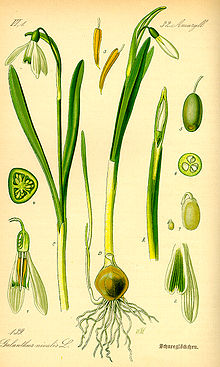Galanthus

Galanthus, snowdrop (from Ancient Greek γάλα, (gála, “milk”) + ἄνθος (ánthos, “flower”)) is a small genus of approximately 20 species of bulbous perennial herbaceous plants in the family Amaryllidaceae. The plants have two linear leaves and a single small white drooping bell shaped flower with six petal-like (petaloid) tepals in two circles (whorls). The smaller inner petals have green markings.
Snowdrops have been known since the earliest times under various names, but were named Galanthus in 1753. As the number of recognised species increased, various attempts were made to divide the species into subgroups, usually on the basis of the pattern of the emerging leaves (vernation). In the era of molecular phylogenetics this characteristic has been shown to be unreliable and now seven molecularly defined clades are recognised that correspond to the biogeographical distribution of species. New species continue to be discovered.
Most species flower in winter, before the vernal equinox (20 or 21 March in the Northern Hemisphere), but some flower in early spring and late autumn. Sometimes snowdrops are confused with the two related genera within the tribe Galantheae, snowflakes Leucojum and Acis.
All species of Galanthus are perennial petaloid herbaceous bulbous (growing from bulbs) monocot plants. The genus is characterised by the presence of two leaves, pendulous white flowers with six free perianth segments in two whorls. The inner whorl is smaller than the outer whorl and has green markings.[2]
